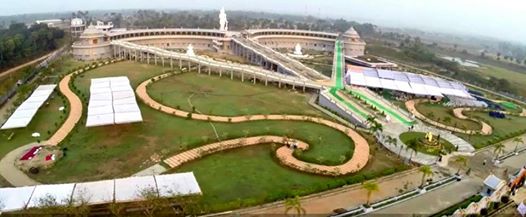#ashokasays Did you know 164:
Neer Mahal
If you are thinking that Palaces inside lakes are limited to Rajasthan then you are absolutely wrong .... You should visit Tripura to experience this place.. Neer Mahal...
Rudrasagar lake is situated roughly 50 Km outside Agartala near Melaghar with 5.3 square kilometers water area. The famous lake palace of Tripura known as “Neermahal” is built in the centre of the lake. Neermahal translates as the Water Palace. Just like the palace in the centre of a lake in Jaipur, Jal Mahal, which also means the water palace, Neermahal is grand and majestic.
The lake is a reservoir for a large number of migratory birds who make it home every winter. Each year a boat race is organized around July/August during Manasa Puja. People need to take a boat accross the Rudrasagar lake (named after Shiva) to reach the palace. The boats can enter the palace. The white marbled structure have huge spaces with good air flow. The serene atmosphere around is very soothing.
Neer Mahal was built in 1930 by Maharaja Bir Bikram Kishore Manikya as summer resort . The palace took 9 years to be built by Martin & Burns Co. The Antar Mahal has 15 royal rooms, courtyard, a room for playing chess and a meeting room where the king addressed his people, among others.
This spectacular monument still reflects the splendour of its past glory and leaves one spellbound.
INCREDIBLE BHARATHA
Neer Mahal
If you are thinking that Palaces inside lakes are limited to Rajasthan then you are absolutely wrong .... You should visit Tripura to experience this place.. Neer Mahal...
Rudrasagar lake is situated roughly 50 Km outside Agartala near Melaghar with 5.3 square kilometers water area. The famous lake palace of Tripura known as “Neermahal” is built in the centre of the lake. Neermahal translates as the Water Palace. Just like the palace in the centre of a lake in Jaipur, Jal Mahal, which also means the water palace, Neermahal is grand and majestic.
The lake is a reservoir for a large number of migratory birds who make it home every winter. Each year a boat race is organized around July/August during Manasa Puja. People need to take a boat accross the Rudrasagar lake (named after Shiva) to reach the palace. The boats can enter the palace. The white marbled structure have huge spaces with good air flow. The serene atmosphere around is very soothing.
Neer Mahal was built in 1930 by Maharaja Bir Bikram Kishore Manikya as summer resort . The palace took 9 years to be built by Martin & Burns Co. The Antar Mahal has 15 royal rooms, courtyard, a room for playing chess and a meeting room where the king addressed his people, among others.
This spectacular monument still reflects the splendour of its past glory and leaves one spellbound.
INCREDIBLE BHARATHA











































